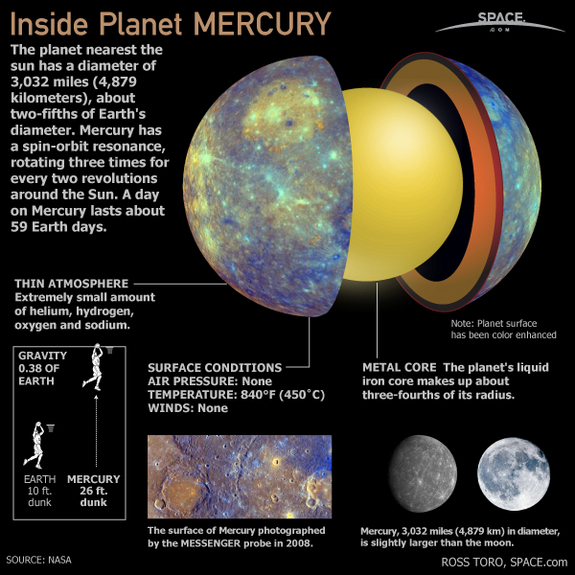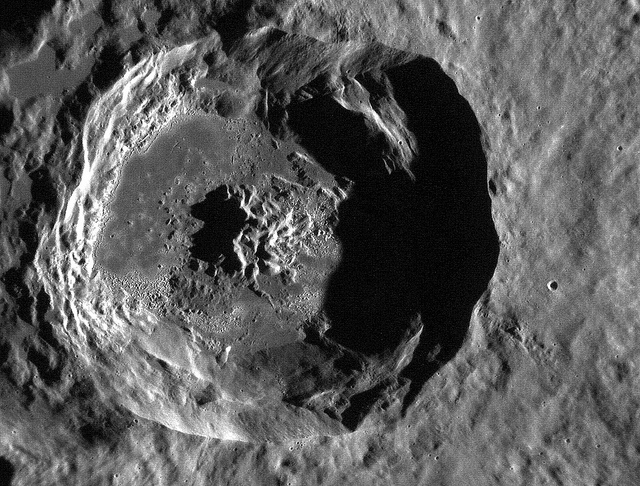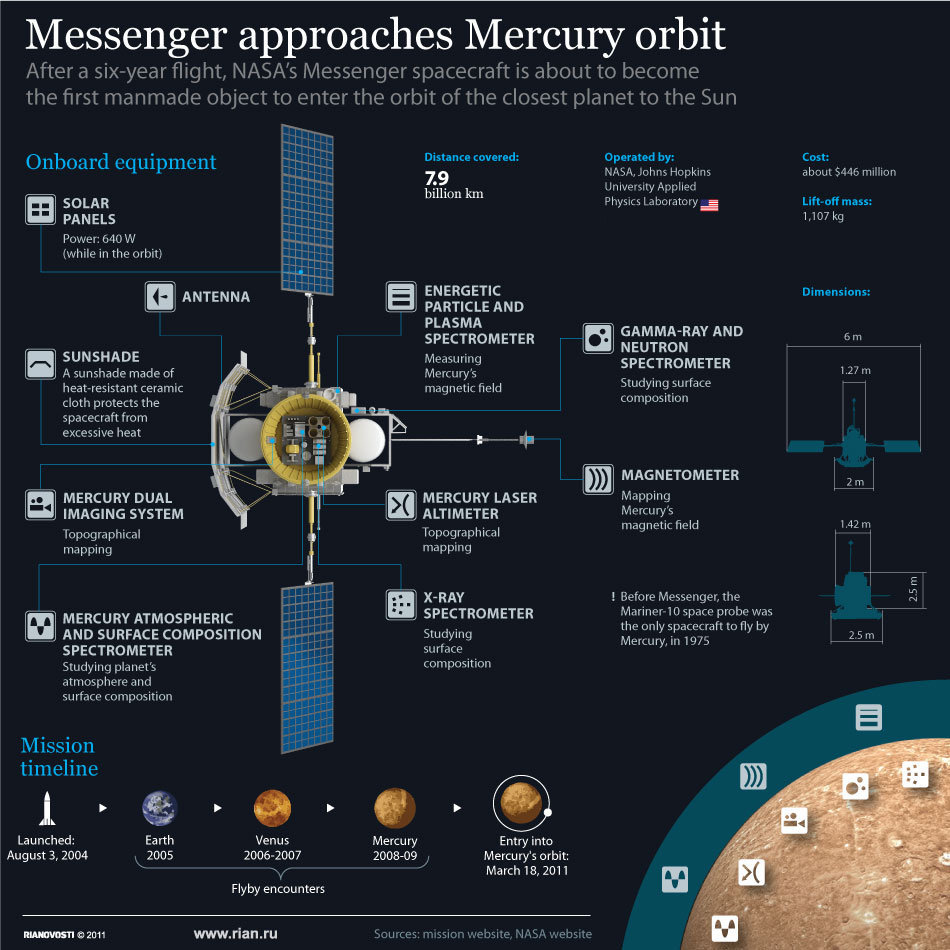Planet Mercury

Named for the fleet-footed messenger of the gods, Mercury is the innermost planet of the solar system. If you have a good eye or a telescope, you can usually see it right after sunset or right before sunrise. (It’s dimmer than Venus and usually a bit lower in the sky.) Because it is closer to the sun than Earth, you can usually watch it go through phases like the Moon if you’re watching through a telescope.
A Quick Look At Mercury
Mercury by the Numbers
- Average distance from sun: 0.387 Astronomical Units (AUs) (5.79 X 10^7 km)
- Eccentricity of orbit: 0.2056
- Maximum distance from sun: 0.467 AUs (6.97 X 10^7 km)
- Minimum distance from sun: 0.306 AUs (4.59 X 10^7 km)
- Inclination of orbit to ecliptic: 7 degrees, 16 seconds
- Average orbital velocity: 47.9 km/s
- Period of rotation: 58.646 days
- Orbital period: 87.969 days
- Inclination of equator to orbit: 0 degrees
- Equatorial diameter: 4878 km; 38.2% of Earth’s diameter
- Mass: 3.31 X 10^23 kg. 5.58% the mass of Earth.
- Average density: 5.44 grams per cubic centimeter.
- Surface Gravity: 38% of Earth’s gravity (0.38 G)
- Escape velocity: 4.3 km/s. 38% the escape velocity of Earth.
- Surface Temperature: Varies wildly. Between -173 degrees Celsius and 430 degrees Celsius (-280 to 800 degrees Farenheit).
Mercury: Day and Year
How long is a day? How long is a year? It depends on which planet you’re standing on. On Earth, a day is about 24 hours and a year is about 365 days. Mercury rotates once every 58.646 Earth days and orbits around the sun once every 87.969 days. Mercury rotates 1.5 times during each orbit. This means that, if you were standing on a mountain on Mercury at “noon,” it would be “midnight” after one orbit (“year”) on Mercury. After another Mercury “year,” it would be noon on your mountain again. That’s right, one day equals two years on Mercury!
How does it do this? Because Mercury is so close to the sun, the sun’s gravity created tidal forces similar to the way the Moon tugs on the Earth to produce tides. This slowed Mercury’s rotation down. Astronomers call this tidal interaction “resonance”.
The length of Mercury’s day explains its wild swings in temperature. Daytime temperatures can soar as high as 700 K (800 degrees Farenheit) and sink as low as 100 K (-280 degrees Farenheit). (K = Kelvin. Temperatures on the Kelvin scale do not get lower than zero.)
Mercury’s orbit is moderately elliptical and Mercury moves faster than could be explained by Newton’s laws. During the 19th century, astronomers thought the weirdness in Mercury’s orbit could be explained by the presence of another planet closer to the sun, which the called “Vulcan” after the Roman god of the forge. It wasn’t until Einstein developed his theory of relativity that Mercury’s fast motion was explained.Mercury’s orbit is moderately elliptical and Mercury moves faster than could be explained by Newton’s laws. During the 19th century, astronomers thought the weirdness in Mercury’s orbit could be explained by the presence of another planet closer to the sun, which the called “Vulcan” after the Roman god of the forge. It wasn’t until Einstein developed his theory of relativity that Mercury’s fast motion was explained.
The Surface of Mercury

Mercury cannot hold an atmosphere. It captures hydrogen and helium from the solar wind, but these elements are quickly blown away. In photographs, the surface of Mercury looks much like the Moon, covered with craters from impacts with other objects during the early years of the solar system. This is due to the lack of wind and rain erosion, which would have eventually filled the craters in.
When the Mariner probe visited Mercury, it took photos of great curved cliffs called lobate scarps. These appear to have formed when the planet cooled and shrank by a few kilometers. These scarps can be up to three kilometers tall and hundreds of kilometers long.

Another interesting feature on Mercury’s surface is the Caloris Basin. “Caloris” is derived from the Latin word for “heat.” At 1300 kilometers in diameter, Caloris Basin is the largest basin on Mercury. It is partially filled with lava flows, some of which may have formed from material that melted at the time of the impact that created it. This basin is also subject to the extremes of Mercury’s wild temperature swings because it is located at one of the two “hot poles” that face the sun at alternate perihelions, or the point in Mercury’s orbit in which it is closest to the sun. Caloris Basin’s temperature at noon can soar above 800 degrees Farenheit (700 Kelvin)!
Mercury appears to have an unusually large metallic core for its size. The NASA probe Mariner 10 discovered a magnetic field that is only one percent the strength of Earth’s, leading scientists to believe that the core has a high sulfur content. The MESSENGER probe may help solve some of the mysteries of Mercury’s magnetic field, including why Mercury has not lost its magnetic field as its core solidified.
How did Mercury get to have such a large core in relation to its size? One theory is that, since it is so close to the sun, the extreme heat vaporized and drove away some of the elements normally found in rocks. Another theory is that a large object slammed into Mercury early in the solar system’s history, blasting away much of the material in the crust. The core survived to sweep up some of the debris, forming a thinner crust.
MESSENGER Probe Orbits Mercury
March 18, 2011

After a six-year journey, the MESSENGER probe has entered orbit around Mercury. Goals include mapping Mercury’s surface using a higher resolution than ever before and also answering questions about Mercury’s magnetic field. On March 29, 2011, MESSENGER radioed back a batch of 363 pictures like the one at right, providing higher-resolution images of Mercury’s surface for the MESSENGER team to study. These are the first images taken from Mercury orbit and will provide scientists with a more complete map of the surface. For more information and images, be sure to check out MESSENGER’s official web site.









